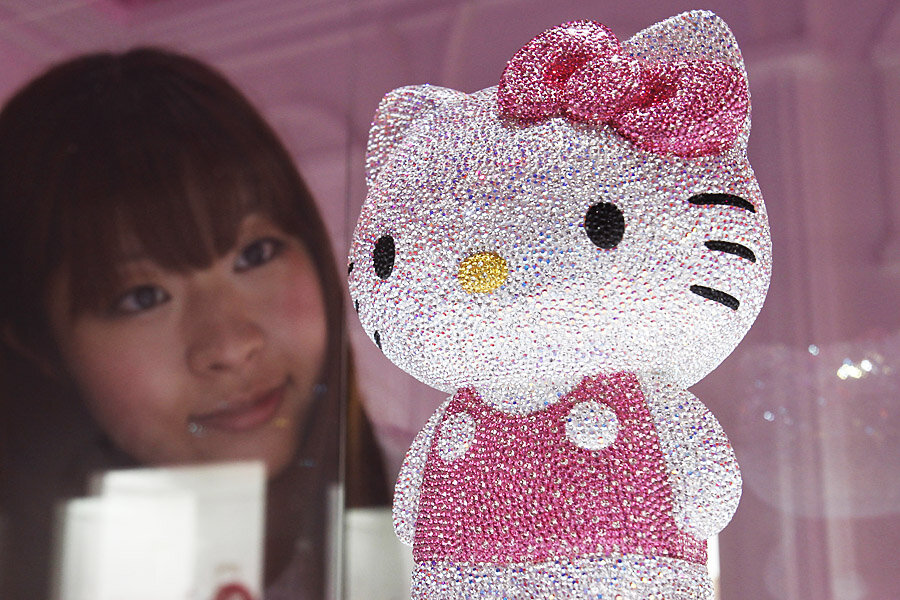Hello Kitty is not a cat, creators say. So what is she?
Loading...
When I see a cat, I call it a cat. Which, in Hello Kitty’s case, was apparently wrong the whole time.
In case you missed it, the world has found itself in the throes of an existential crisis over the news that Hello Kitty, one of the most beloved animated felines of our time, is not, in fact, a cat. According to her creators, Hello Kitty is actually a little girl living with her family in London, as she has been for the entirety of her 40-year existence.
If you were misled into assuming Hello Kitty’s cat status by way of her cat ears, whiskers, and name (which is not, perhaps more helpfully, Hello Feline-like Humanoid), you aren’t alone. The head-scratching revelation comes courtesy of a 40th -Anniversary Hello Kitty retrospective at the Japanese American National Museum in Lost Angeles. The show’s curator, anthropologist Christine R. Yano, has studied the Hello Kitty phenomenon for years and in 2013 published a book on the subject called "Pink Globalization: Hello Kitty's Trek Across the Pacific." And even she was mistaken.
“That's one correction [Hello Kitty merchandising company] Sanrio made for my script for the show,” Ms. Yano told the Los Angeles Times. “Hello Kitty is not a cat. She's a cartoon character. She is a little girl. She is a friend. But she is not a cat. She's never depicted on all fours. She walks and sits like a two-legged creature. She does have a pet cat of her own, however, and it's called Charmmy Kitty."
The Internet has reacted with shock, bemusement, and a lot of bad wordplay – (“Hello Kitty not a cat leaves some feline glum,” lamented the Washington Post), and the species designations of a slew of beloved cartoon characters were called into question – can Donald Duck be a duck if he can drive an RV? Bugs Bunny eats carrots and lives in a dirt hole, but he talks and apparently owns clothing and furniture, so…?
However, read a little more closely, Sanrio’s insistence that Hello Kitty is not a cat doesn’t mean that she is, in fact, something else. The company’s corrections to Yano’s exhibit notes did not insist explicitly that she is a human child, and both the professor and Hello Kitty’s designers have emphasized her inscrutability as a key part of her global appeal. Hello Kitty doesn’t have a mouth, for example, so that people can "project their feelings onto the character" or “be happy or sad together with Hello Kitty,” head Hello Kitty designer Yuko Yamaguchi told Time in 2009.
"Hello Kitty works and is successful partly because of the blankness of her design," Yano told the LA Times "People see the possibility of a range of expressions. You can give her a guitar, you can put her on stage, you can portray her as is. That blankness gives her an appeal to so many types of people."
That mass appeal has led to four decades of all-but-uninterrupted global popularity and profits to the tune of an estimated $7 billion in 2014. Since first appearing on a vinyl coin purse in 1974, she’s been the (expressionless) face of countless products, including toys, fashion accessories, several animated TV shows, and video games. Bank of America has sold Hello Kitty-themed checking accounts, and the Taiwanese jetliner EVA air has a fleet of Hello Kitty-themed jets. In 2010, there was even a short-lived line of high-end Hello Kitty wines.
Of course, Hello Kitty has a carefully fleshed out backstory, complete with a family, pets, and many similarly expressionless, vaguely animal-like friends. But the information given, including her Zodiac sign and list of hobbies, are meant to expand the breadth of her appeal without making it too specialized (there aren’t a lot of people in the world who don’t enjoy “traveling,” “listening to music,” and “really delicious cookies”).
So it may just be that pegging her as a singular species is too specific. So go ahead and follow Sanrio’s advice and make Hello Kitty whatever you want her to be – she defies categorization.








